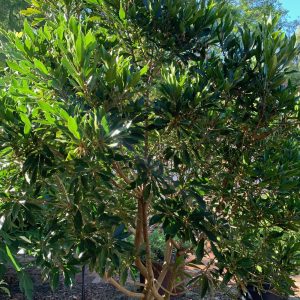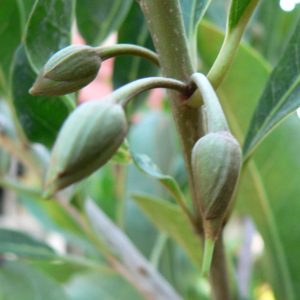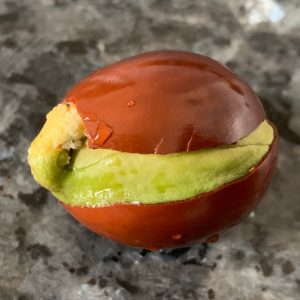Lucuma (Pouteria)bifera(lucuma)
Lucuma, lucmo
Origin
Lucuma is native to cooler Andean valleys of Peru, Ecuador and northern Chile where it has been grown for hundreds of years, with various depictions seen in ancient Inca artefacts. It is not widely known outside these areas, and even less outside South America.
Climate
Most members of the genus are tropical, but lucuma is better adapted to a frost-free sub-tropical or cool tropical climate, with mean annual temperatures in the range 8-27°C. The limiting southern latitude appears to be about 33°, with failures reported at 36°S. In Chile it is found from sea level up to elevations of 1000m, and in more tropical regions it is seen up to 3000m. Preferred annual precipitation is 1000-1800mm. It does not do well in hot tropical lowland areas and can tolerate some dry seasonal periods.
Plant Description
An attractive evergreen lactiferous tree that grows to 6-12m with a dense, low-hanging, 5-10m diameter rounded crown. Leaves are simple, coriaceous, 10-20cm long X 8cm wide, obovate, oval or elliptic with a blunt apex and more acute base, and clustered in whorls at the ends of branches. The upper surface is dark green, the lower pale green and sometimes pubescent.
Relatives
It belongs to the large Sapotaceae Family which has been difficult taxonomically, with more than 50 genera and 1200 species. Family relatives are star apple, sapodilla and miracle fruit. Pouteria is the largest genus with 325 species divided into 9 sections, and lucuma has many historical synonyms. Pouteria relatives are mamey and green sapote and abiu. Canistel (Pouteria campechiana) is probably the closest species to lucuma, both botanically and in terms of fruit characteristics among those more commonly known.
Soils
It is relatively undemanding, growing best in rich loams but also in sandy through to clayish soils, and has some tolerance to salinity.
Propagation
There is a low success rate with seed germination and it can be slow (25-40 days). Seedlings have a long juvenility period (7-15 years) and also do not come true to type, resulting in marked variability in tree and fruit characteristics. Grafting can be difficult but is the preferred approach, as fruit production is more predictable and may commence in 4-5 years from planting out. Named rootstocks have not been developed so far. Whip or cleft grafts are used in spring when stems are 4-6mm diameter, and there are some reports of improved ‘take’ by applying rooting hormone (auxin) to the grafted area to accelerate cambial and callus growth. Copious latex in the graft region should be allowed to drain before attempting the graft. Grafted plants using seedling rootstocks still show variability and work is being undertaken with micro-propagation techniques to improve standardisation and predictability. There has also been some success with cuttings.
Cultivars
There are no named varieties and only two fruit forms that have been selected from chance seedlings – one has soft flesh when ripe and the other firmer. Limited systematic breeding work is currently underway but so far has not resulted in release of any superior cultivars.
Flowering and Pollination
The tree flowers and fruits throughout the whole year. Flower buds occur in small clusters along terminal twigs. Individual buds are about 3cm in length not counting the stem, tubular in shape, sepals are a light reddish brown and hairy, with fleshy, light yellow-green petals protruding. Pollination is by bees.
Cultivation
Lucuma can be grown in climates similar to that for the Hass avocado. No scientific work has been done on fertilisation practice but protocols similar to citrus seem to suffice. When young, weed control is important, as growth in the first 2 years is slow; mulching is also beneficial.
Wind Tolerance
Good.
Pruning
Pruning begins when young to form 3-4 well-spaced main scaffold branches that will open up the canopy. Thereafter branches longer than 30-40cm can be tipped to promote further branching. In mature trees, serial thinning of individual main branches may be undertaken to keep the canopy productive, and dead or damaged wood should be removed.
The Fruit
The fruit is a berry, oblate, ovate or elliptic, pointed or depressed at the apex and 7.5-10cm long with thin brownish-green skin. Flesh is hard and oozes latex when immature. As it matures, skin colour may or may not change to a yellowish-green, latex disappears and the flesh becomes softer and very sweet, yellow to orange-yellow. Edible flesh, minus peel and seeds is 70-80% of the fruit, and is dry and mealy with consistency similar to a hard-boiled egg yolk; pulp moisture content is 65-70%. There are 1-5 shiny dark brown seeds with a narrow whitish hilum on one flattened side. Carbohydrate content when ripe is 16-19% with most being due to glucose and fructose and smaller amounts of sucrose. Lucuma pulp also contains miraculin, the glycoprotein found in miracle fruit that modifies taste receptors to perceive acidic foods as sweet. Without vegetative propagation, size, peel colour, pulp texture, fibre, colour and aroma, seed number, harvest period and yield can all vary greatly.
Fruit Production and Harvesting
Fruit take 8-9 months to mature from pollination. Grafted plants may produce 5-6kg of fruit/tree after 4 years inground, gradually increasing to 60kg/tree by year 10. Good trees may yield up to 500 fruits weighing 100-200g each (exceptionally 1kg). Lucuma is a climacteric fruit but will not ripen properly if picked when still immature. However determining the best time to harvest is problematic as skin colour may change only slightly from green to yellow-green or hardly at all. Nevertheless they should be picked before they drop as flesh is then delicate and the thin skin does not afford protection from bruising. They should be kept at room temperature for ripening (3-10 days), indicated by marked softening; scratching should also not release any latex. Fully mature fruit can be kept at 13-15°C for 2-3 weeks.
Fruit Uses
The fresh fruit is very popular in its native areas but the dry mealy texture does not appeal to everyone. It is more commonly eaten in processed forms where it is used to flavour beverages, ice-creams, pastries and other desserts. Pulp can be stored frozen or dried, with the latter often ground to a yellow-orange powder for use in beverages, baking and other products. The flavour has been described as similar to coffee, vanilla and butterscotch with a hint of maple syrup.
Pests and Diseases
Generally minimal problems. In South America pests that have been reported include fruit fly, hairy worm, whitefly and scale, and the main disease can be powdery mildew on leaves. The fruit is very attractive to birds and all fruit-eating creatures.
Comments
Lucuma is difficult to source in WA and likely to be a seedling exhibiting significant sexual variation. Plus you may have to wait for several years to get through the juvenile stage. However as a sub-tropical growing in lowland Central Chile it crops reasonably well in the Perth surrounds, as does one of its near relatives, canistel. Our winters do not trouble it. You’ll have to ensure it gets sufficient watering in our dry climate. Well-managed fully mature trees can be very good croppers, so if you succeed and no matter how much you can eat fresh, experimentation with all sorts of processed forms will be needed to cope with the output!




